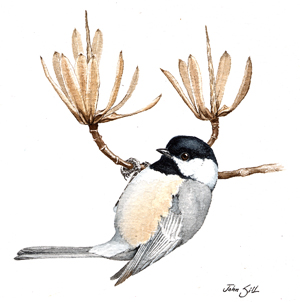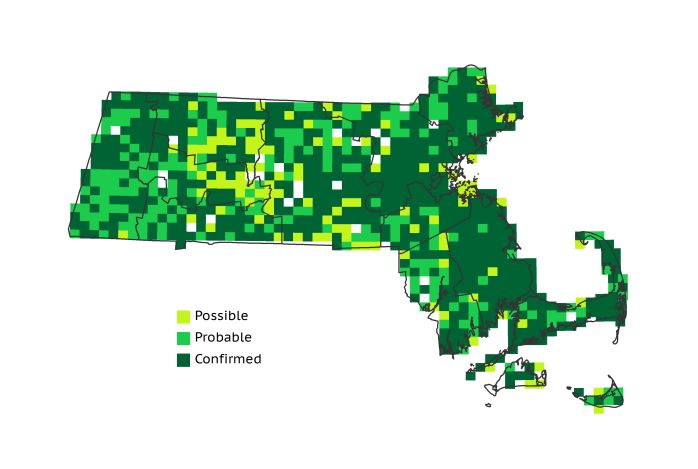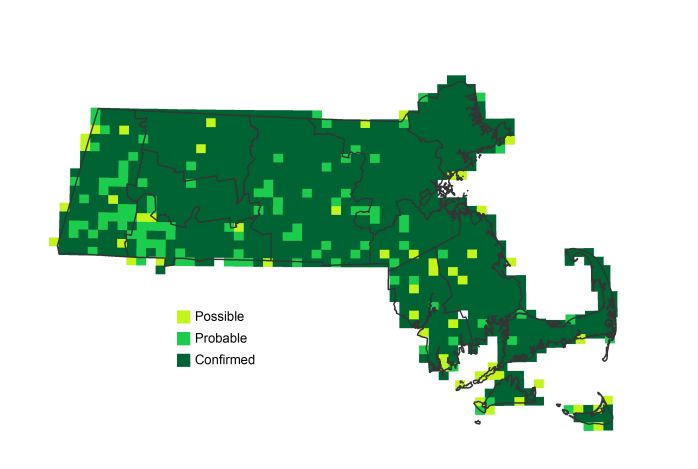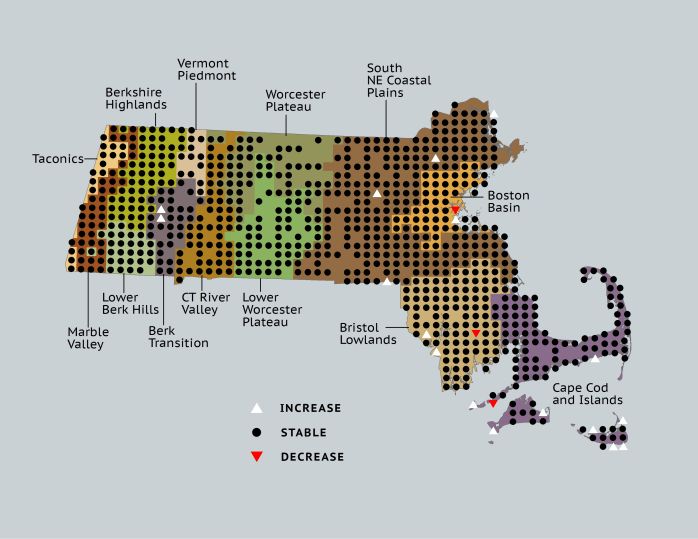Find a Bird
Black-capped Chickadee
Poecile atricapillus

Nearly ubiquitous and stable

“When piped a tiny voice hard by, / Gay and polite, a cheerful cry, / Chic-chicadeedee! saucy note / Out of sound heart and merry throat,” – Ralph Waldo Emerson, “The Titmouse”
The Black-capped Chickadee was an apt choice to represent the Commonwealth as the state bird of Massachusetts since few species are as at home in the mix of forest, agricultural land, and suburban development that characterizes the Bay State today. Flocks of Black-capped Chickadees are common visitors to backyard bird feeders, where they constantly take seeds away one at a time to be cracked and consumed under the safety of brushy cover. The population of these bold, acrobatic birds seems to be thriving today.
Historic Status
Known to early Massachusetts residents as the Black-cap Titmouse, the chickadee is as versatile a bird as any in Massachusetts. It can be found in many habitats statewide, through all seasons of the year, and, as such, has been dubbed the state bird of Massachusetts. “Let the north winds howl, let the snowstorm rage—it may be bitter cold,but Chickadee worries not as he hustles about to keep his little stomach filled with insects,” wrote ornithologist Maurice Broun (Forbush 1929). No major changes in the status of the Black-capped Chickadee in Massachusetts have been recorded over time.
Atlas 1 Distribution
In its capacity as our state bird, the Black-capped Chickadee seemingly aspired to make its presence known in all corners of the Commonwealth during Atlas 1. West of the Connecticut River Valley, it is possible to count on one hand all of the blocks that failed to report evidence of breeding chickadees. Moving eastward, the Lower Worcester Plateau reported half a dozen blocks with no chickadees – more than many other regions, but still only a small percentage of the total. A few empty blocks each in the Coastal Plains and Boston Basin were likewise little more than lone exceptions to the rule of chickadee ubiquity. The Bristol/Narragansett Lowlands and the Cape and Islands were almost completely occupied, though the offshore islands recorded several blocks with no chickadees.
Atlas 2 Distribution and Change
After canvassing the state in an attempt to gain favor in the relatively few blocks it had not conquered during the Atlas 1, the state bird found homes in 999 blocks in Atlas 2. Perhaps more remarkably, Atlas workers Confirmed nesting attempts in 4 out of every 5 blocks in Atlas 2, as compared with 3 out of 5 in Atlas 1. It almost seemed harder to not find a nesting Black-capped Chickadee in Atlas 2 than to find one. While still not the most widespread avian species in the state (tied for sixth with Mourning Dove), it was clearly as versatile during Atlas 2 as it was in centuries past. Black-capped Chickadees remain as ubiquitous as ever.
Atlas 1 Map

Atlas 2 Map

Atlas Change Map

Ecoregion Data
Atlas 1 | Atlas 2 | Change | ||||||
Ecoregion | # Blocks | % Blocks | % of Range | # Blocks | % Blocks | % of Range | Change in # Blocks | Change in % Blocks |
Taconic Mountains | 15 | 93.8 | 1.7 | 24 | 96.0 | 2.4 | 0 | 0.0 |
Marble Valleys/Housatonic Valley | 39 | 100.0 | 4.3 | 39 | 100.0 | 3.9 | 0 | 0.0 |
Berkshire Highlands | 54 | 98.2 | 6.0 | 55 | 100.0 | 5.5 | 0 | 0.0 |
Lower Berkshire Hills | 28 | 100.0 | 3.1 | 30 | 96.8 | 3.0 | 0 | 0.0 |
Vermont Piedmont | 17 | 100.0 | 1.9 | 17 | 100.0 | 1.7 | 0 | 0.0 |
Berkshire Transition | 36 | 94.7 | 4.0 | 39 | 97.5 | 3.9 | 2 | 6.5 |
Connecticut River Valley | 54 | 96.4 | 6.0 | 63 | 96.9 | 6.3 | 0 | 0.0 |
Worcester Plateau | 77 | 98.7 | 8.5 | 88 | 100.0 | 8.8 | 0 | 0.0 |
Lower Worcester Plateau | 68 | 91.9 | 7.5 | 80 | 100.0 | 8.0 | 0 | 0.0 |
S. New England Coastal Plains and Hills | 258 | 95.6 | 28.4 | 280 | 98.9 | 28.0 | 4 | 1.8 |
Boston Basin | 49 | 87.5 | 5.4 | 50 | 89.3 | 5.0 | 0 | 0.0 |
Bristol and Narragansett Lowlands | 102 | 96.2 | 11.2 | 107 | 93.9 | 10.7 | 1 | 1.0 |
Cape Cod and Islands | 110 | 80.9 | 12.1 | 127 | 88.2 | 12.7 | 7 | 5.8 |
Statewide Total | 907 | 93.6 | 100.0 | 999 | 96.3 | 100.0 | 14 | 1.7 |
Notes
The Black-capped Chickadee shows a significant increasing Breeding Bird Survey trend in the Eastern US overall.



